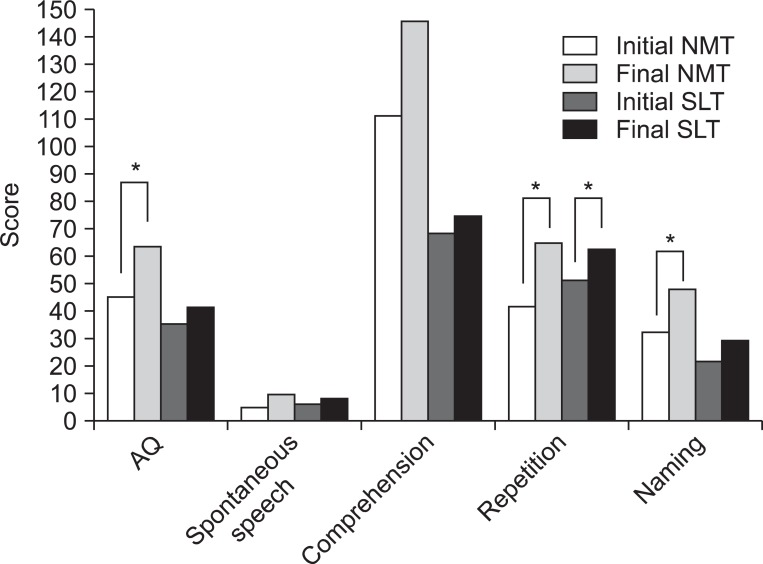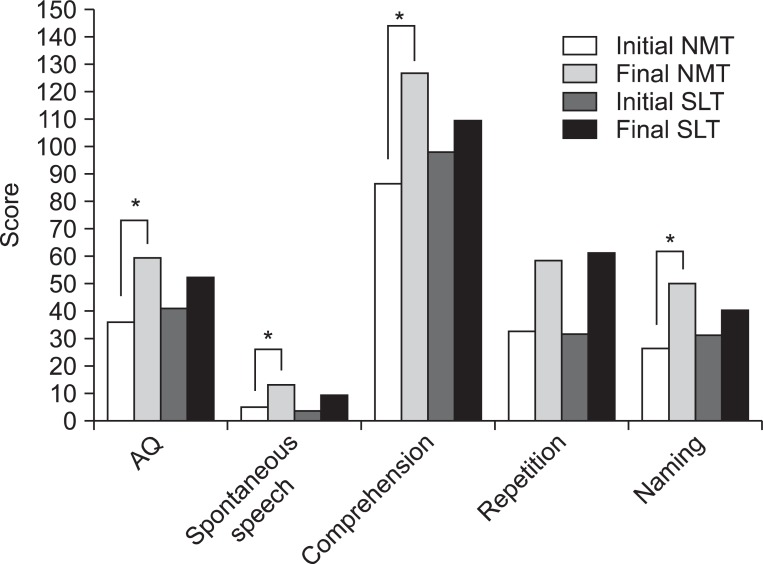Ann Rehabil Med.
2013 Aug;37(4):556-562. 10.5535/arm.2013.37.4.556.
The Therapeutic Effect of Neurologic Music Therapy and Speech Language Therapy in Post-Stroke Aphasic Patients
- Affiliations
-
- 1Department of Rehabilitation Medicine, Inje University College of Medicine, Ilsan Paik Hospital, Goyang, Korea. wholespirit@hanmail.net
- 2Department of Rehabilitation Medicine, Kwandong University College of Medicine, Myungji Hospital, Goyang, Korea.
- 3Speech Therapy, Inje University Ilsan Paik Hospital, Goyang, Korea.
- KMID: 2266612
- DOI: http://doi.org/10.5535/arm.2013.37.4.556
Abstract
OBJECTIVE
To investigate the therapeutic effect of neurologic music therapy (NMT) and speech language therapy (SLT) through improvement of the aphasia quotient (AQ) in post-stroke aphasic patients.
METHODS
Twenty-one post-stroke, nonfluent aphasia patients who had ischemic/hemorrhagic stroke on radiologic evaluation were divided into the NMT and SLT groups. They received NMT and SLT for 1 month. Language function was assessed by Korean version-Western Aphasia Battery before and after therapy. NMT consisted of therapeutic singing and melodic intonation therapy, and SLT consisted of language-oriented therapy.
RESULTS
Significant improvements were revealed in AQ, repetition, and naming after therapy in the NMT group and improvements in repetition in the SLT group of chronic stroke patients (p<0.05). There were significant improvements in language ability in the NMT group of subacute stroke patients. However, there was no significant improvement in the SLT group of subacute stroke patients.
CONCLUSION
We concluded that the two therapies are effective treatments in the chronic stage of stroke and NMT is effective in subacute post-stroke aphasic patients.
Keyword
MeSH Terms
Figure
Reference
-
1. Engelter ST, Gostynski M, Papa S, Frei M, Born C, Ajdacic-Gross V, et al. Epidemiology of aphasia attributable to first ischemic stroke: incidence, severity, fluency, etiology, and thrombolysis. Stroke. 2006; 37:1379–1384. PMID: 16690899.2. Wade DT, Wood VA, Hewer RL. Recovery after stroke: the first 3 months. J Neurol Neurosurg Psychiatry. 1985; 48:7–13. PMID: 3973623.3. Walker-Batson D, Avent JR. Adult neurogenic communication disorders. In : Braddom RL, editor. Physical medicine and rehabilitation. 3rd ed. Philadelphia: Saunders;2007. p. 49–62.4. Berthier ML, Pulvermuller F. Neuroscience insights improve neurorehabilitation of poststroke aphasia. Nat Rev Neurol. 2011; 7:86–97. PMID: 21297651.
Article5. Berthier ML. Poststroke aphasia: epidemiology, pathophysiology and treatment. Drugs Aging. 2005; 22:163–182. PMID: 15733022.6. Sparks RW, Holland AL. Method: melodic intonation therapy for aphasia. J Speech Hear Disord. 1976; 41:287–297. PMID: 950787.
Article7. Helm-Estabrooks N, Fitzpatrick PM, Barresi B. Visual action therapy for global aphasia. J Speech Hear Disord. 1982; 47:385–389. PMID: 6194372.
Article8. Lee JH, Yoo WK, Jung KI, Kim DH, Park DS, Im HJ. The therapeutic effect of inhibitory repetitive transcranial magnetic stimulation on right inferior frontal gyrus in subcortical aphasia. J Korean Acad Rehabil Med. 2007; 31:70–77.9. Berthier ML, Hinojosa J, Martin Mdel C, Fernandez I. Open-label study of donepezil in chronic poststroke aphasia. Neurology. 2003; 60:1218–1219. PMID: 12682346.
Article10. Thaut MH, Gardiner JC, Holmberg D, Horwitz J, Kent L, Andrews G, et al. Neurologic music therapy improves executive function and emotional adjustment in traumatic brain injury rehabilitation. Ann N Y Acad Sci. 2009; 1169:406–416. PMID: 19673815.
Article11. Belin P, Van Eeckhout P, Zilbovicius M, Remy P, Francois C, Guillaume S, et al. Recovery from nonfluent aphasia after melodic intonation therapy: a PET study. Neurology. 1996; 47:1504–1511. PMID: 8960735.
Article12. Schlaug G, Marchina S, Norton A. From singing to speaking: why singing may lead to recovery of expressive language function in patients with Broca's aphasia. Music Percept. 2008; 25:315–323. PMID: 21197418.
Article13. Kim HH, Na DL. Paradise Korean version the Western Aphasia Battery. Seoul: Paradise Welfare Foundation;2001.14. Bohland JW, Guenther FH. An fMRI investigation of syllable sequence production. Neuroimage. 2006; 32:821–841. PMID: 16730195.
Article15. Brown S, Martinez MJ, Hodges DA, Fox PT, Parsons LM. The song system of the human brain. Brain Res Cogn Brain Res. 2004; 20:363–375. PMID: 15268914.
Article16. Guenther FH, Hampson M, Johnson D. A theoretical investigation of reference frames for the planning of speech movements. Psychol Rev. 1998; 105:611–633. PMID: 9830375.
Article17. Jeffries KJ, Fritz JB, Braun AR. Words in melody: an H(2)15O PET study of brain activation during singing and speaking. Neuroreport. 2003; 14:749–754. PMID: 12692476.
Article18. Thaut MH, Kenyon GP, Schauer ML, McIntosh GC. The connection between rhythmicity and brain function. IEEE Eng Med Biol Mag. 1999; 18:101–108. PMID: 10101675.
Article19. Lahav A, Saltzman E, Schlaug G. Action representation of sound: audiomotor recognition network while listening to newly acquired actions. J Neurosci. 2007; 27:308–314. PMID: 17215391.
Article
- Full Text Links
- Actions
-
Cited
- CITED
-
- Close
- Share
- Similar articles
-
- Current Evidence for Post Stroke Aphasia Treatment
- Relations between Language Impairment and Functional Communication in Post-Stroke Aphasia
- The Factors Associated with Good Responses to Speech Therapy Combined with Transcranial Direct Current Stimulation in Post-stroke Aphasic Patients
- Current Approaches to the Treatment of Post-Stroke Aphasia
- Aphasia and the Diagram Makers Revisited: an Update of Information Processing Models



